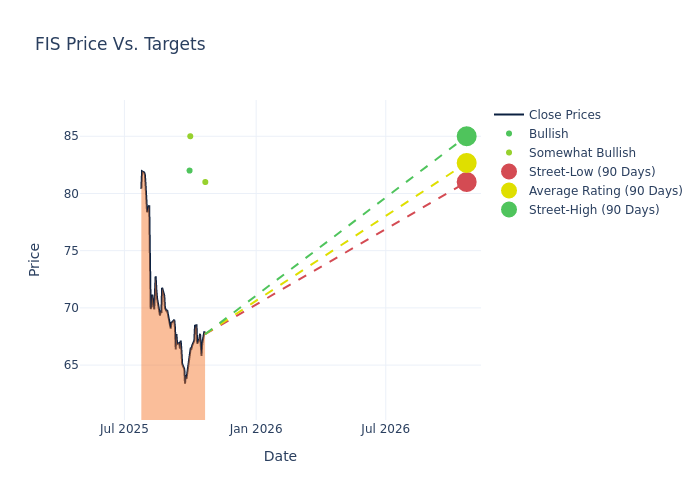Beyond The Numbers: 5 Analysts Discuss Fidelity National Info Stock
In the latest quarter, 5 analysts provided ratings for Fidelity National Info (NYSE:FIS), showcasing a mix of bullish and bearish perspectives.
The table below summarizes their recent ratings, showcasing the evolving sentiments within the past 30 days and comparing them to the preceding months.
| Bullish | Somewhat Bullish | Indifferent | Somewhat Bearish | Bearish | |
|---|---|---|---|---|---|
| Total Ratings | 1 | 3 | 1 | 0 | 0 |
| Last 30D | 0 | 1 | 0 | 0 | 0 |
| 1M Ago | 1 | 1 | 0 | 0 | 0 |
| 2M Ago | 0 | 0 | 0 | 0 | 0 |
| 3M Ago | 0 | 1 | 1 | 0 | 0 |
Insights from analysts' 12-month price targets are revealed, presenting an average target of $83.6, a high estimate of $88.00, and a low estimate of $81.00. A decline of 3.35% from the prior average price target is evident in the current average.

Analyzing Analyst Ratings: A Detailed Breakdown
In examining recent analyst actions, we gain insights into how financial experts perceive Fidelity National Info. The following summary outlines key analysts, their recent evaluations, and adjustments to ratings and price targets.
| Analyst | Analyst Firm | Action Taken | Rating | Current Price Target | Prior Price Target |
|---|---|---|---|---|---|
| Jason Kupferberg | Wells Fargo | Announces | Overweight | $81.00 | - |
| Vasundhara Govil | Keefe, Bruyette & Woods | Lowers | Outperform | $85.00 | $88.00 |
| Timothy Chiodo | UBS | Maintains | Buy | $82.00 | $82.00 |
| Vasundhara Govil | Keefe, Bruyette & Woods | Lowers | Outperform | $88.00 | $92.00 |
| Timothy Chiodo | UBS | Lowers | Neutral | $82.00 | $84.00 |
Key Insights:
- Action Taken: Analysts frequently update their recommendations based on evolving market conditions and company performance. Whether they 'Maintain', 'Raise' or 'Lower' their stance, it reflects their reaction to recent developments related to Fidelity National Info. This information provides a snapshot of how analysts perceive the current state of the company.
- Rating: Analysts assign qualitative assessments to stocks, ranging from 'Outperform' to 'Underperform'. These ratings convey the analysts' expectations for the relative performance of Fidelity National Info compared to the broader market.
- Price Targets: Delving into movements, analysts provide estimates for the future value of Fidelity National Info's stock. This analysis reveals shifts in analysts' expectations over time.
Understanding these analyst evaluations alongside key financial indicators can offer valuable insights into Fidelity National Info's market standing. Stay informed and make well-considered decisions with our Ratings Table.
Stay up to date on Fidelity National Info analyst ratings.
Discovering Fidelity National Info: A Closer Look
Fidelity National Information Services provides core processing and ancillary services to banks, but its business has expanded over time. By acquiring SunGard in 2015, the company now provides record-keeping and other services to investment firms. With the acquisition of Worldpay in 2019, FIS was providing payment processing services for merchants and holding leading positions in the United States and United Kingdom. But the company sold off a majority interest in Worldpay and now has only a minority stake.
Fidelity National Info: A Financial Overview
Market Capitalization: With restricted market capitalization, the company is positioned below industry averages. This reflects a smaller scale relative to peers.
Revenue Growth: Fidelity National Info's remarkable performance in 3M is evident. As of 30 June, 2025, the company achieved an impressive revenue growth rate of 5.06%. This signifies a substantial increase in the company's top-line earnings. When compared to others in the Financials sector, the company faces challenges, achieving a growth rate lower than the average among peers.
Net Margin: Fidelity National Info's net margin is below industry standards, pointing towards difficulties in achieving strong profitability. With a net margin of -17.97%, the company may encounter challenges in effective cost control.
Return on Equity (ROE): Fidelity National Info's ROE is below industry averages, indicating potential challenges in efficiently utilizing equity capital. With an ROE of -3.22%, the company may face hurdles in achieving optimal financial returns.
Return on Assets (ROA): Fidelity National Info's ROA falls below industry averages, indicating challenges in efficiently utilizing assets. With an ROA of -1.42%, the company may face hurdles in generating optimal returns from its assets.
Debt Management: Fidelity National Info's debt-to-equity ratio is below the industry average. With a ratio of 0.92, the company relies less on debt financing, maintaining a healthier balance between debt and equity, which can be viewed positively by investors.
The Core of Analyst Ratings: What Every Investor Should Know
Within the domain of banking and financial systems, analysts specialize in reporting for specific stocks or defined sectors. Their work involves attending company conference calls and meetings, researching company financial statements, and communicating with insiders to publish "analyst ratings" for stocks. Analysts typically assess and rate each stock once per quarter.
Analysts may enhance their evaluations by incorporating forecasts for metrics like growth estimates, earnings, and revenue, delivering additional guidance to investors. It is vital to acknowledge that, although experts in stocks and sectors, analysts are human and express their opinions when providing insights.
Which Stocks Are Analysts Recommending Now?
Benzinga Edge gives you instant access to all major analyst upgrades, downgrades, and price targets. Sort by accuracy, upside potential, and more. Click here to stay ahead of the market.
This article was generated by Benzinga's automated content engine and reviewed by an editor.